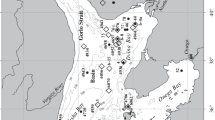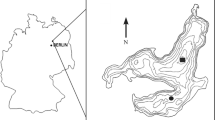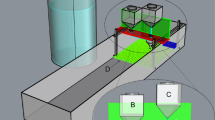Abstract
A Lagrangian model is used to evaluate source regions of particles collected in the sediment traps at the DYFAMED (Dynamique des Flux Atmosphériques en Méditerranée) station by tracking particles backwards from March 1 to August 31, 2001. The analysis suggests that source regions depend on the flow fields, the settling speed of the particles, and the deployment depths of the traps. Monthly variation is observed in the distribution patterns of source regions, which is caused by the currents. The source regions are located around the traps and up to hundreds of kilometers away. As the settling speed increases with the particle diameters, the distance to the source regions decreases. The vertical flux can be approximately estimated in 1D for the particles with diameters larger than 500 μm. Furthermore, traps moored at various depths at the DYFAMED can collect particles that originated from different regions in the Ligurian Sea.
Similar content being viewed by others
References
Alldredge A L, Gotschalk C. 1988. In situ settling behavior of marine snow. Limnol Oceanogr, 339–351
Auclair F, Marsaleix P, Estournel C. 2001. The penetration of the Northern Current over the Gulf of Lions (Mediterranean) as a downscaling problem. Oceanol Acta, 24: 529–544
Bienfang P K. 1980. Herbivore diet affects fecal pellet settling. Can J Fish Aquat Sci, 37: 1352–1357
Bouffard J, Vignudelli S, Herrmann M, et al. 2008. Comparison of ocean dynamics with a regional circulation model and improved altimetry in the north-western Mediterranean. Terr Atmos Ocean Sci, 19: 117–133
Buesseler K O, Antia A N, Chen M, et al. 2007. An assessment of the use of sediment traps for estimating upper ocean particle fluxes. J Mar Res, 65: 345–416
Buesseler K O, Trull T W, Steinberg D K, et al. 2008. VERTIGO (VERtical Transport In the Global Ocean): A study of particle sources and flux attenuation in the north Pacific. Deep-Sea Res Part II-Top Stud Oceanogr, 55: 1522–1539
Denny M. 1993. Air and Water: The Biology and Physics of Life’s Media. Princeton: Princeton University Press. 341
Deuser W G, Muller-Karger F E, Evans R H, et al. 1990. Surface-ocean color and deep-ocean carbon flux: how close a connection? Deep-Sea Res Part I-Oceanogr Res Pap, 37: 1331–1343
Estournel C, Auclair F, Lux M, et al. 2007. “Scale oriented” embedded modeling of the North-Western Mediterranean in the frame of MFSTEP. Ocean Sci Discuss, 4: 145–187
Gaspar P, Grégoris Y, Lefevre J. 1990. A simple eddy kinetic energy model for simulations of the oceanic vertical mixing: Tests at station Papa and long-term upper ocean study site. J Geophys Res, 95: 16179–16193
Gatti J, Petrenko A, Devenon J, et al. 2006. The Rhone river dilution zone present in the northeastern shelf of the Gulf of Lion in December 2003. Cont Shelf Res, 26: 1794–1805
Guidi-Guilvard L D. 2002. DYFAMED-BENTHOS, a long time-series benthic survey at 2347-m depth in the northwestern Mediterranean: general introduction. Deep-Sea Res Part II-Top Stud Oceanogr, 49: 2183–2193
Hill P S, Syvitski J P, Cowan E A, et al. 1998. In situ observations of floc settling velocities in Glacier Bay, Alaska. Mar Geol, 145: 85–94
Honjo S, Francois R, Manganini S, et al. 2000. Particle fluxes to the interior of the Southern Ocean in the Western Pacific sector along 170 W. Deep-Sea Res Part II-Top Stud Oceanogr, 47: 3521–3548
Hu Z Y, Doglioli A M, Petrenko A A, et al. 2009. Numerical simulations of eddies in the Gulf of Lion. Ocean Model, 28: 203–208
Hu Z Y, Petrenko A A, Doglioli A M, et al. 2011. Study of a mesoscale anticyclonic eddy in the western part of the Gulf of Lion. J Marine Syst, 88: 3–11
Keslin J, Sokolov M, Wakeham W. 1978. Viscosity of liquid water in the range −8°C to 15°°C. J Phys Chem Ref Data, 7: 941–948
Marsaleix P, Auclair F, Floor J W, et al. 2008. Energy conservation issues in sigma-coordinate free-surface ocean models. Ocean Model, 20: 61–89
Marty J, Chiavérini J. 2002. Seasonal and interannual variations in phytoplankton production at DYFAMED time-series station, northwestern Mediterranean Sea. Deep-Sea Res Part II-Top Stud Oceanogr, 49: 2017–2030
Neuer S, Ratmeyer V, Davenport R, et al. 1997. Deep water particle flux in the Canary Island region: Seasonal trends in relation to long-term satellite derived pigment data and lateral sources. Deep-Sea Res Part I-Oceanogr Res Pap, 44: 1451–1466
Petrenko A, Leredde Y, Marsaleix P. 2005. Circulation in a stratified and wind-forced Gulf of Lions, NW Mediterranean Sea: in situ and modeling data. Cont Shelf Res, 25: 7–27
Qiu Z F, Doglioli A M, Hu Z Y, et al. 2010. The influence of hydrodynamic processes on zooplankton transport and distributions in the north western Mediterranean: Estimates from a Lagrangian model. Ecol Model, 221: 2816–2827
Qiu Z, Doglioli A M, He Y, et al. 2011. Lagrangian model of zooplankton dispersion: Numerical schemes comparisons and parameter sensitivity tests. Chin J Oceanol Limnol, 29: 438–445
Shanks A L, Trent J D. 1980. Marine snow: sinking rates and potential role in vertical flux. Deep-Sea Res Part I-Oceanogr Res Pap, 27: 137–143
Siegel D A, Deuser W G. 1997. Trajectories of sinking particles in the Sargasso Sea: Modeling of statistical funnels above deep-ocean sediment traps. Deep-Sea Res Part I-Oceanogr Res Pap, 44: 1519–1541
Siegel D A, Fields E, Buesseler K O. 2008. A bottom-up view of the biological pump: modeling source funnels above ocean sediment traps. Deep-Sea Res Part I-Oceanogr Res Pap, 55: 108–127
Siegel D A, Granata T C, Michaels A F, et al. 1990. Mesoscale eddy diffusion, particle sinking, and the interpretation of sediment trap data. J Geophys Res, 95: 5305–5311
Stemmann L, Gorsky G, Marty J, et al. 2002. Four-year study of large-particle vertical distribution (0–1000 m) in the NW Mediterranean in relation to hydrology, phytoplankton, and vertical flux. Deep-Sea Res Part II-Top Stud Oceanogr, 49: 2143–2162
Syvitski J P, Asprey K W, Leblanc K. 1995. In-situ characteristics of particles settling within a deep-water estuary. Deep-Sea Res Part II-Top Stud Oceanogr, 42: 223–256
Trull T W, Bray S G, Buesseler K O, et al. 2008. In situ measurement of mesopelagic particle sinking rates and the control of carbon transfer to the ocean interior during the Vertical Flux in the Global Ocean (VERTIGO) voyages in the north Pacific. Deep-Sea Res Part II-Top Stud Oceanogr, 55: 1684–1695
Waniek J, Koeve W, Prien R D. 2000. Trajectories of sinking particles and the catchment areas above sediment traps in the northeast Atlantic. J Mar Res, 58: 983–1006
Xue J H. 2008. The Chemical Composition of Sinking Particles and their Vertical Dynamics in the Open Ocean. Doctoral Dissertation. Stony Brook: Stony Brook University
Author information
Authors and Affiliations
Corresponding author
Rights and permissions
About this article
Cite this article
Qiu, Z., Doglioli, A.M. & Carlotti, F. Using a Lagrangian model to estimate source regions of particles in sediment traps. Sci. China Earth Sci. 57, 2447–2456 (2014). https://doi.org/10.1007/s11430-014-4880-x
Received:
Accepted:
Published:
Issue Date:
DOI: https://doi.org/10.1007/s11430-014-4880-x




